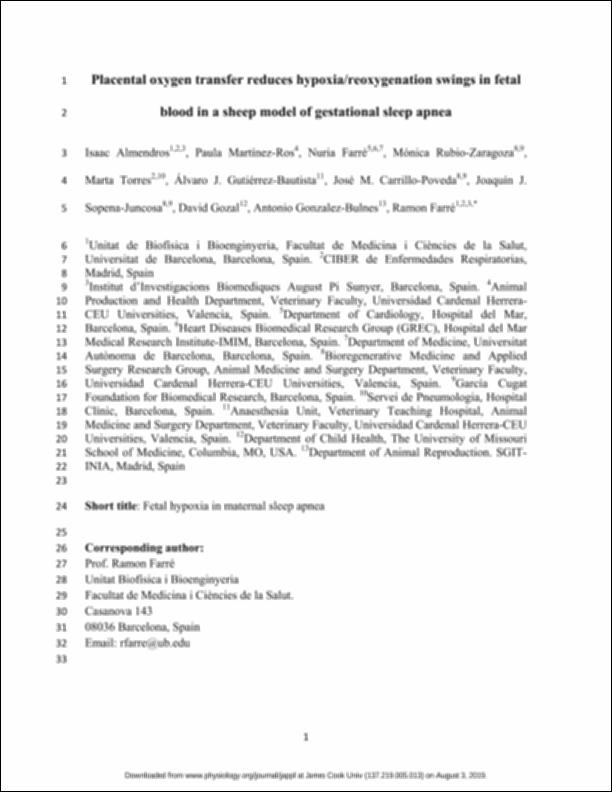Por favor, use este identificador para citar o enlazar este ítem:
http://hdl.handle.net/10637/11753Placental oxygen transfer reduces hypoxia-reoxygenation swings in fetal blood in a sheep model of gestational sleep apnea
| Título : | Placental oxygen transfer reduces hypoxia-reoxygenation swings in fetal blood in a sheep model of gestational sleep apnea |
| Autor : | Almendros, Isaac Martínez Ros, Paula Farré López, Nuria Rubio Zaragoza, Mónica. Torres Torrillas, Marta Gutiérrez Bautista, Álvaro Jesús Carrillo Poveda, José María. Sopena Juncosa, Joaquín Jesús. Gozal, David González de Bulnes López, Antonio Farré, Ramon |
| Materias: | Fetal blood.; Sangre fetal.; Sueño - Trastornos.; Sleep disorders.; Fetal anoxia.; Embarazo - Complicaciones y secuelas.; Anoxia fetal.; Oxygen in the body.; Pregnancy - Complications.; Oxígeno en el organismo. |
| Editorial : | American Physiological Society. |
| Citación : | Almendros, I., Martínez-Ros, P., Farré, N., Rubio-Zaragoza, M., Torres, M., Gutiérrez-Bautista. ÁJ. et al. (2019). Placental oxygen transfer reduces hypoxia-reoxygenation swings in fetal blood in a sheep model of gestational sleep apnea. Journal of Applied Physiology (1985), vol. 127, i. 3 (sep.), pp. 745-752. DOI: https://doi.org/10.1152/japplphysiol.00303.2019 |
| Resumen : | AIM: Obstructive sleep apnea (OSA), characterized by events of hypoxia reoxygenation, is highly prevalent in pregnancy, negatively affecting the gestation process and particularly the fetus. Whether the consequences of OSA on the fetus and offspring are mainly caused by systemic alterations in the mother or by direct effect of intermittent hypoxia in the fetus is unknown. In fact, how apnea-induced hypoxemic swings in OSA are transmitted across the placenta remains to be investigated. The aim of this study was to test the hypothesis, based on a theoretical background on the dampening effect of oxygen transfer in the placenta, that oxygen partial pressure (PO2) swings resulting from obstructive apneas mimicking OSA are mitigated in the fetal circulation. METHODS: To this end, 4 anesthetized ewes close to term pregnancy were subjected to obstructive apneas consisting of 25-s airway obstructions. Real time PO2 was measured in the maternal carotid artery and in the umbilical vein using fast-response fiberoptic oxygen sensors. RESULTS: The amplitude of PO2 swings in the umbilical vein were considerably smaller (3.1±1.0 vs. 21.0±6.1 mmHg (m±SE); p<0.05). Corresponding estimated swings in fetal and maternal oxyhemoglobin saturation tracked PO2 swings. CONCLUSION: This study provides novel insights into fetal oxygenation in a model of gestational OSA, and highlights the importance of further understanding the impact of sleep-disordered-breathing on fetal and offspring development. |
| Descripción : | Este artículo se encuentra disponible en la página web de la revista en la siguiente URL: https://journals.physiology.org/doi/full/10.1152/japplphysiol.00303.2019?rfr_dat=cr_pub++0pubmed&url_ver=Z39.88-2003&rfr_id=ori%3Arid%3Acrossref.org This is the pre-peer reviewed version of the following article: Almendros, I., Martínez-Ros, P., Farré, N., Rubio-Zaragoza, M., Torres, M., Gutiérrez-Bautista, A.J. et al. (2019). Placental oxygen transfer reduces hypoxia-reoxygenation swings in fetal blood in a sheep model of gestational sleep apnea. Journal of Applied Physiology, vol. 127, i. 3 (13 sep.), pp. 745-752, which has been published in final form at https://doi.org/10.1152/japplphysiol.00303.2019. Este es el pre-print del siguiente artículo: Almendros, I., Martínez-Ros, P., Farré, N., Rubio-Zaragoza, M., Torres, M., Gutiérrez-Bautista, A.J. et al. (2019). Placental oxygen transfer reduces hypoxia-reoxygenation swings in fetal blood in a sheep model of gestational sleep apnea. Journal of Applied Physiology, vol. 127, i. 3 (13 sep.), pp. 745-752, que se ha publicado de forma definitiva en https://doi.org/10.1152/japplphysiol.00303.2019. |
| URI : | http://hdl.handle.net/10637/11753 |
| Derechos: | http://creativecommons.org/licenses/by-nc-nd/4.0/deed.es |
| ISSN : | 8750-7587 1522-1601 (Electrónico) |
| Fecha de publicación : | 1-sep-2019 |
| Centro : | Universidad Cardenal Herrera-CEU |
| Aparece en las colecciones: | Dpto. Producción y Sanidad Animal, Salud Pública Veterinaria y Ciencia y Tecnología de los Alimentos |
Los ítems de DSpace están protegidos por copyright, con todos los derechos reservados, a menos que se indique lo contrario.


